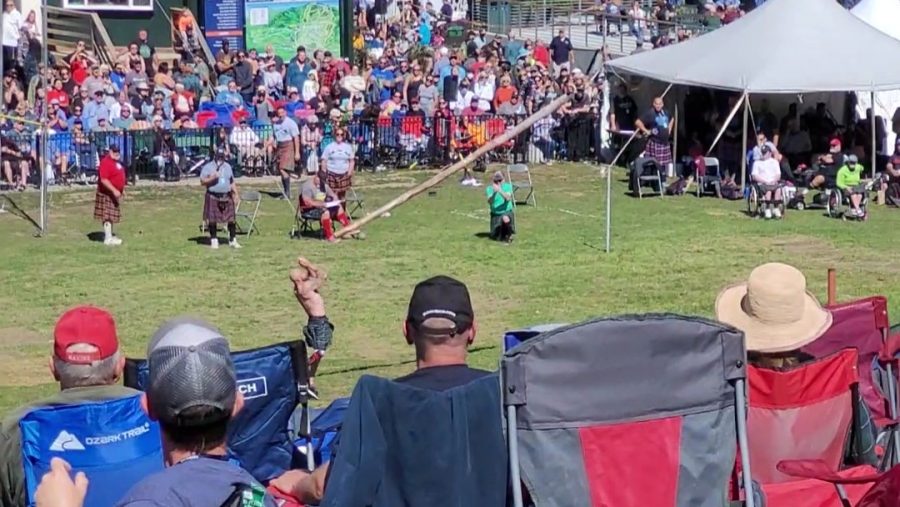Cultural events are becoming more inclusive
The NH Highland Games and Festival attracts all sorts of tourists, celtic sports fans, pipe band enthusiasts, and now cosplayers
September 22, 2022
Last weekend, I had the privilege of attending the New Hampshire Highland Games at Loon Mountain in Lincoln, New Hampshire. This event combines the very best of traditional Scottish athletics, food, and culture, complete with the sounds of pipe bands echoing off of the granite faces of the White Mountains. The crowds were awash with tartan, the traditional medium of colorful woven fabric, with attendees displaying their family heritage or favorite color scheme. Yet, in the sea of casual, traditional, and even formal highland dress, there was the periodic glimpse of something quite the opposite of traditional. Barbaric figures bearing comedically gargantuan swords, hammers, and axes pressed their way through the lines of onlookers. Characters which looked to have been plucked from amongst the extras of an episode of Game of Thrones dotted the festival, causing the multitudes to shy away in an awkward movement to give these individuals room to maneuver with their bulky weaponry, partly fearful, partly shocked, and partly enamored by these fantastical figures. WHile these particular attendees would seem fit right in at a Renaissance Fair(e), I have to pose the question, do they belong at the Highland Games?
The simplest and most brief answer I can offer is yes, of course they belong at the Games or any such event, since all people from any walks of life are welcomed by the open, slightly inebriated arms of the American Scots. The longer answer, however, requires a bit more deliberation on the history and tradition of the Highland Games, and cultural celebrations in general.
The Highland Games, according to tradition, date as far back as 1500 B.C., when clans and nobles would meet to put their strongest warriors, most skilled artisans, fairest singers, and most talented storytellers to the test. Though, it can be argued that sports such as stone lifting, weight throwing, and wrestling can be organically invented all around the world, and may well be older than civilization itself. Over the next 3,300 years or so, the tradition of Celtic sports and competitions continued, until Queen Victoria and Prince Albert made the modern equivalent of the Highland Games fashionable with a visit to Scotland in 1848. With this visit, Celtic culture in general became incredibly popular in Britain and the rest of the world. Tartan, the aforementioned Scottish style of fabric, migrated out of the Highlands and into the rest of British high society. Along with it came the kilt, originally a utilitarian outer garment for Scottish warriors, cattle drovers, and woodsmen, now trimmed, tailored, and updated for military and formal dress in the 19th century. Celtic immigrants coming to America, facing the strong English and Germanic cultural majority in the United States, continued their games and traditions across the pond as a haven for their own culture in the melting pot of turn-of-the-century America.
With this long and complex history in mind, there is no doubt that the Highland Games serve as a significant bastion for both the history and culture of the Celtic peoples from the last 3,500 years. With such a rich tradition of real, tangible history, why do some people choose to cosplay as characters from the fantasy realm when attending the Highland Games? It seems that this decision is largely up to personal choice. Expression of personal interests, in modern times, is arguably just as important as the expression of family and cultural history at the Highland Games. While the whimsical attire, caricature war-paint, unwieldy seven foot tall hammers, and fantasy aesthetic don’t match my personal tastes for attending the Games (I prefer the casual look while I save up for a more historically accurate wardrobe) those who do dawn such regalia clearly put in a lot of effort to enjoy themselves. Toting around a fantastically large wooden mace while in full armor for the duration of the day-long event is certainly no small feat. Whether this is to be applauded or laughed at I’ll leave up to you, but I think it says something about the dedication to self and to culture that these folks have. I believe that for the very survival of culture, festivals must be inclusive, and that maybe a millennia old tradition still leaves room for modernization.



